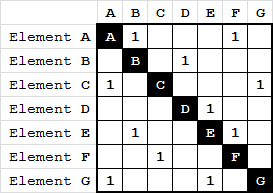Related Research Articles

Feedback occurs when outputs of a system are routed back as inputs as part of a chain of cause-and-effect that forms a circuit or loop. The system can then be said to feed back into itself. The notion of cause-and-effect has to be handled carefully when applied to feedback systems:
Simple causal reasoning about a feedback system is difficult because the first system influences the second and second system influences the first, leading to a circular argument. This makes reasoning based upon cause and effect tricky, and it is necessary to analyze the system as a whole. As provided by Webster, feedback in business is the transmission of evaluative or corrective information about an action, event, or process to the original or controlling source.
A performance appraisal, also referred to as a performance review, performance evaluation, (career) development discussion, or employee appraisal, sometimes shortened to "PA", is a periodic and systematic process whereby the job performance of an employee is documented and evaluated. This is done after employees are trained about work and settle into their jobs. Performance appraisals are a part of career development and consist of regular reviews of employee performance within organizations.
360-degree feedback is a process through which feedback from an employee's subordinates, peers, colleagues, and supervisor(s), as well as a self-evaluation by the employee themselves is gathered. Such feedback can also include, when relevant, feedback from external sources who interact with the employee, such as customers and suppliers or other interested stakeholders. 360-degree feedback is so named because it solicits feedback regarding an employee's behavior from a variety of points of view. It therefore may be contrasted with "downward feedback", or "upward feedback" delivered to supervisory or management employees by subordinates only.
In control theory, an open-loop controller, also called a non-feedback controller, is a control system in which the control action is independent of the "process output", which is the process variable that is being controlled. It does not use feedback to determine if its output has achieved the desired goal of the input command or process setpoint.

A feed forward is an element or pathway within a control system that passes a controlling signal from a source in its external environment to a load elsewhere in its external environment. This is often a command signal from an external operator.

A feedforward neural network (FNN) is an artificial neural network wherein connections between the nodes do not form a cycle. As such, it is different from its descendant: recurrent neural networks.

Internal communications (IC) is the function responsible for effective communications among participants within an organization. The scope of the function varies by organization and practitioner, from producing and delivering messages and campaigns on behalf of management, to facilitating two-way dialogue and developing the communication skills of the organization's participants.
Conflict management is the process of limiting the negative aspects of conflict while increasing the positive aspects of conflict. The aim of conflict management is to enhance learning and group outcomes, including effectiveness or performance in an organizational setting. Properly managed conflict can improve group outcomes.

The design structure matrix (DSM; also referred to as dependency structure matrix, dependency structure method, dependency source matrix, problem solving matrix (PSM), incidence matrix, N2 matrix, interaction matrix, dependency map or design precedence matrix) is a simple, compact and visual representation of a system or project in the form of a square matrix.

Employee engagement is a fundamental concept in the effort to understand and describe, both qualitatively and quantitatively, the nature of the relationship between an organization and its employees. An "engaged employee" is defined as one who is fully absorbed by and enthusiastic about their work and so takes positive action to further the organization's reputation and interests. An engaged employee has a positive attitude towards the organization and its values. In contrast, a disengaged employee may range from someone doing the bare minimum at work, up to an employee who is actively damaging the company's work output and reputation.
Formative assessment, formative evaluation, formative feedback, or assessment for learning, including diagnostic testing, is a range of formal and informal assessment procedures conducted by teachers during the learning process in order to modify teaching and learning activities to improve student attainment. The goal of a formative assessment is to monitor student learning to provide ongoing feedback that can help students identify their strengths and weaknesses and target areas that need work. It also helps faculty recognize where students are struggling and address problems immediately. It typically involves qualitative feedback for both student and teacher that focuses on the details of content and performance. It is commonly contrasted with summative assessment, which seeks to monitor educational outcomes, often for purposes of external accountability.
Control is a function of management which helps to check errors in order to take corrective actions. This is done to minimize deviation from standards and ensure that the stated goals of the organization are achieved in a desired manner.
Post Occupancy Evaluation (POE) has its origins in Scotland and the United States and has been used in one form or another since the 1960s. Preiser and colleagues define POE as "the process of evaluating buildings in a systematic and rigorous manner after they have been built and occupied for some time".
Feedforward is the provision of context of what one wants to communicate prior to that communication.
Video self-modeling (VSM) is a form of observational learning in which individuals observe themselves performing a behavior successfully on video, and then imitate the targeted behavior. VSM allows individuals to view themselves being successful, acting appropriately, or performing new tasks. Peter Dowrick, a key researcher in the development of self-modeling, described two forms of VSM, feedforward and self-review. Self-review involves someone with a relatively well developed skill watching examples of best performance. A good example of this is the procedure used by Laura Wilkinson, gold medal platform diver, prior to every meet. In an interview after her gold medal performance, she was asked how she prepares for competition. She said that she watches a video that consists of her best dives along with encouragement from family and coaches. Self-review is mainly used in sports training as a form of visual imaging. Feedforward, on the other hand, is used with people who do not have a skill or when a new skill is emerging. Thus, feedforward is the method most often used in instructional or clinical settings. Because Feedforward involves new skills or behaviors performed by the viewer, it usually requires some degree of video editing to make it appear that the viewer is performing in an advanced manner. The term feedforward can be contrasted with the more traditional term feedback as it relates to receiving information about performance. Feedback allows people to see how they are doing. Feedforward allows them to see how they could be performing; a future self. Feedforward is mainly used in education and therapy circles and mainly with children with disabilities. It has been found to be especially effective with children with autism who tend to be visual learners and who seem to attend better to monitors than to live models.
In an organization, communication occurs between members of different hierarchical positions. Superior-subordinate communication refers to the interactions between organizational leaders and their subordinates and how they work together to achieve personal and organizational goals Satisfactory upward and downward communication is essential for a successful organization because it closes the gap between superior and subordinates by increasing the levels of trust, support, and the frequency of their interactions.
Computational heuristic intelligence (CHI) refers to specialized programming techniques in computational intelligence. These techniques have the express goal of avoiding complexity issues, also called NP-hard problems, by using human-like techniques. They are best summarized as the use of exemplar-based methods (heuristics), rather than rule-based methods (algorithms). Hence the term is distinct from the more conventional computational algorithmic intelligence, or GOFAI. An example of a CHI technique is the encoding specificity principle of Tulving and Thompson. In general, CHI principles are problem solving techniques used by people, rather than programmed into machines. It is by drawing attention to this key distinction that the use of this term is justified in a field already replete with confusing neologisms. Note that the legal systems of all modern human societies employ both heuristics from individual trial records as well as legislated statutes (rules) as regulatory guides.
Harwood research refers to research in organizational psychology that took place at Harwood Manufacturing, a Virginia-based textiles manufacturer, over the course of four decades in the early to mid-Twentieth Century.
Internet interventions for posttraumatic stress have grown in popularity due to the limits that many patients face in their ability to seek therapy to treat their symptoms. These limits include lack of resources and residing in small towns or in the countryside. These patients may find it difficult to seek treatment because they do not have geographical access to treatment, and this can also limit the time they have to seek help. Additionally, those who live in rural areas may experience more stigma related to mental health issues. Internet interventions can increase the possibility that those who suffer from PTSD can seek help by eliminating these barriers to treatment.
Feedforward is the provision of context of what one wants to communicate prior to that communication. In purposeful activity, feedforward creates an expectation which the actor anticipates. When expected experience occurs, this provides confirmatory feedback.
References
- ↑ Avraham Kluger. "Feedforward first, Feedback later" (PDF). Retrieved 2014-10-21.
- 1 2 Marshall Goldsmith. "Want to Give Feedback? Rather Try Feedforward!" (PDF). Retrieved 2012-05-09.